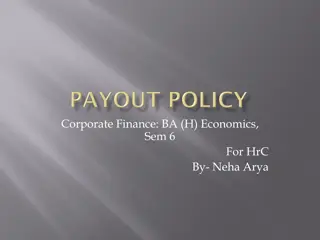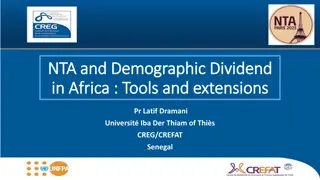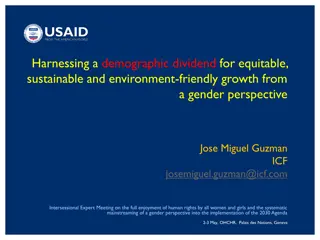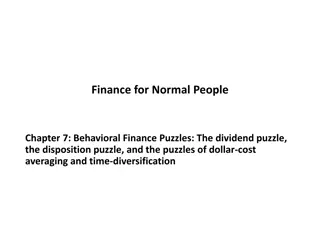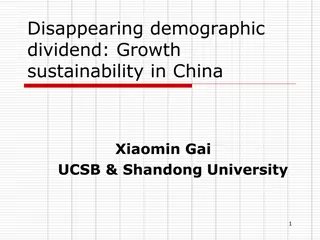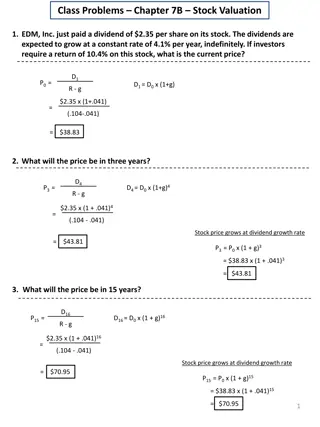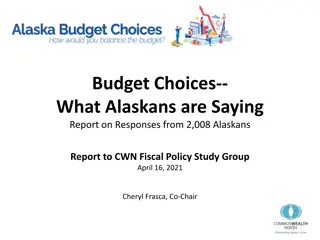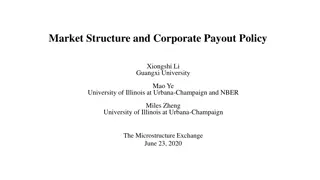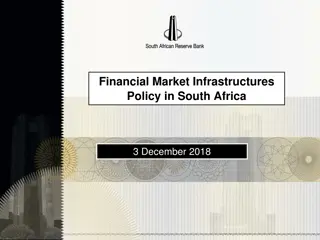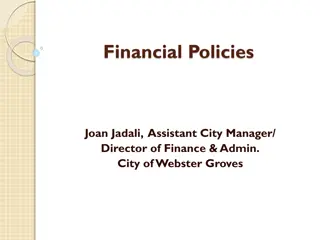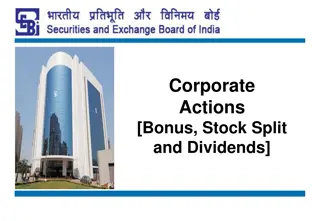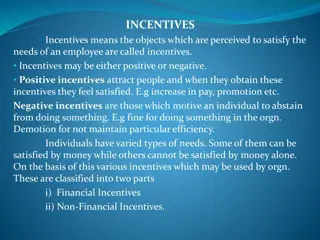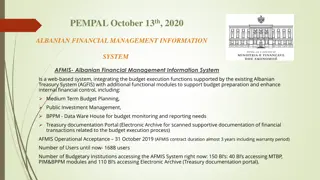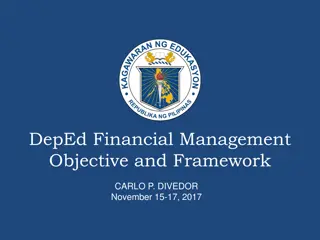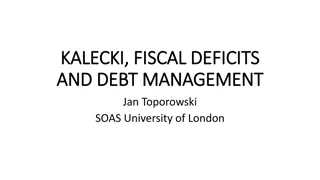Understanding Dividend Policy in Financial Management
Dividend policy in financial management involves decisions regarding the distribution of earnings to shareholders and retained earnings. It includes types of dividends, time of payment, and dimensions impacting the policy. Various dividend theories like Modigliani and Miller's Model, Walter's Model, and Gordon's Model are discussed, highlighting the relevance and irrelevance theories. Walter's Model emphasizes the impact of dividends on stock prices over the long term, considering factors such as constant return in the cost of capital and internal financing.
Download Presentation

Please find below an Image/Link to download the presentation.
The content on the website is provided AS IS for your information and personal use only. It may not be sold, licensed, or shared on other websites without obtaining consent from the author. Download presentation by click this link. If you encounter any issues during the download, it is possible that the publisher has removed the file from their server.
E N D
Presentation Transcript
DIVIDEND POLICY By : Amit Mitra Sub: financial management Chapter: dividend policy Semester: 6th
What is Dividend? A dividend is a distribution to shareholders out of profit or reserve available for this purpose .
Types of Dividend On the basis of mode of payment On the basis of types of share Equity Dividend Preference Dividend Cash dividend Stock dividend Bond dividend Property dividend Composite dividend
On the basis of time of payment Interim dividend Regular dividend Special dividend
What is Dividend Policy : Dividend policy determines the division of earnings between payments to shareholders and retained earnings .
Dimensions of Dividend policy Funds requirement Liquidity Access to external sources of financing Shareholder preference Difference in the cost of external equity and retained earnings Control Taxes
Dividend Theories
Dividend Theories (i.e. which consider dividend decision to be irrelevant as it does not affects the value of the firm) Relevance Theories Irrelevance Theories (i.e. which consider dividend decision to be relevant as it affects the value of the firm) Modigliani and Miller s Model Walter s Model Traditional Approach Gordon s Model
Relevance Theories
Walters Model Prof. James E Walter argued that in the long run the share price reflect only the present value of expected dividends. Retentions influence stock price only through their effect on future dividends. Walter has formulated this and used the dividend to optimize the wealth of the equity shareholders.
Assumptions of Walter's Model Internal Financing Constant return in cost of capital 100% payout or retention Constant EPS and DPS Infinite time
Formula of Walter's Model P = D + r/k (E-D) K Where, P = Current market price of equity share E = Earning per share D = Dividend per share (E-D) = Retained earning per share r = Rate of return on firm s investment or internal rate of return K = cost of equity capital
Illustration According to Walter:- When r>k, the firm should retain the maximum earning, that is, the firm should pay out minimum or no dividend. Then the value of equity share of the firm will be maximum. Growth firm (r>k): r=15% k=10% E=5 If D=5 then p = 5+0.15(0)/0.10 = Rs. 50 0.10 If D=2 then p = 2+0.15(3)/0.10 = Rs. 65 0.10
Normal firm(r=k) When r=k, the firm can remain indifferent regarding dividend pay-out decision. In this case value of equity share of the firm remain unchanged whatever may be the dividend pay-out ratio. r=10% k=10% E=5 If D=5 then p = 5+0.10(0)/0.10 = Rs. 50 0.10 If D=2 then p = 2+0.10(3)/0.10 = Rs. 50 0.10
Declining Firm (r<k) When r<k, the firm should pay out all its profit to the shareholders as dividend without creating any reserve. Then only the value of equity share will be maximum. r=10% k=15% E=5 If D=5 then p = 5+0.10(0)/0.15 = Rs. 50 0.15 If D=2 then p = 2+0.10(3)/0.15 = Rs. 26.67 0.15
Effect of dividend policy on value of share Case If dividend payout ratio increases If dividend payout ratio decreases 1. In case of growing firm i.e where r >k Market value of share decreases Market value of share increases 2. In case of declining firm i.e where r<k Market value of share increases Market value of share decreases 3. In case of normal firm i.e where r=k No changes in value of share No changes in value of share
Criticisms of Walter's Model No external financing Firm s internal rate of return does not always remain constant. In fact, r decreases as more and more investment in made. Firm s cost of capital does not always remain constant. In fact k changes directly with the firm s risk.
Gordons Model According to prof. Gordon, dividend policy almost always affects the value of the firm. He showed how dividend policy can be used to maximize the wealth of the shareholders. The main proposition of the model is that the value of a share reflects the value of the future dividends accuring to that share. Hence the dividend payment and it s growth are relevant in valuation of shares. The model holds that the share s market price is equal to the sum of share s discounted future dividend payment.
Assumptions All equity firm No external financing Constant returns Constant cost of capital Perpetual earnings No taxes Constant retention Cost of capital is greater than growth rate(k>br=g)
Formula of Gordons Model P =E (1-b) K-br Where, P = Price per share E = Earning per share r = rate of return on investment k = cost of capital b = % of retained earnings = retention ratio = Retained earnings/Total earnings br = g = growth rate of the firm
Illustration Growth firm (r>k) r=20% k= 15% E= Rs. 4 If b=0.25 then P= 4(0.75) = Rs. 30 0.15-(0.25)(0.20) If b=0.50 then p= 4(0.50) = Rs. 40 0.15-(0.5)(0.20)
Illustration Normal firm (r=k) r=15% k= 15% E= Rs. 4 If b=0.25 then P= 4(0.75) = Rs. 26.67 0.15-(0.25)(0.15) If b=0.50 then p= 4(0.50) = Rs. 26.67 0.15-(0.5)(0.15)
Illustration Declining firm (r<k): r=10% k= 15% E= Rs. 4 If b=0.25 then P= 4(0.75) = Rs. 24 0.15-(0.25)(0.10) If b=0.50 then p= 4(0.50) = Rs. 20 0.15-(0.5)(0.10)
Criticisms of Gordon's Model As the assumptions of Walter's model and Gordon's model are same so the Gordon's model suffers from the same limitations as the Walter's model.
Irrelevance Theories
Modigliani-Miller Hypothesis for Dividend policy:- M-M Hypothesis provides the irrelevant concept of dividend in comprehensive manner. According to them, the dividend policy of a firm does not have any effect on the price of share of a firm, i.e., it does not affect the shareholders wealth.
Assumptions:- Existence of perfect capital market. Taxes do no exist. Investors behave rationally. Investment policy of the firm do not change. Risk and uncertainty does not exist.
Formula of M-M approach Where no new financing exist, the value of the firm (V) will be as follows:- V = np = n (P1 + D1) (1 + k) Computation of total amount of finance required for financing a new project, i.e., new financing:- Amount required = I (y nD1) Where, I = Total Investment y = Total earnings D1= Dividend per share at the one year end n = number of shares. According to M-M hypothesis:- P0 = (P1 + D1) (1 + k) Where, P0 = market price per share at time zero P1 = market price per share at time one D1 = dividend per share at time one k = cost of capital or discounting rate.
Formula of M-M approach Number of shares required to be issued for the new investment:- Market price per share at the end of the year. n = Amount required for new investment Where, V = Value of the firm m = number of shares newly issued year = I (y nD1) P1 Computation of the Total Value of the firm at the end of the year:- V = (n +m) P1 I + y (1 + k) n= Number of shares P1 = market price per share at the end of the I = Total investment y = total earnings k = cost of capital.
Criticism of M-M Model No perfect capital market Existence of transaction cost Existence of floatation cost Lack of relevant information Different rates of taxes No fixed investment policy Investor s desire to obtain current income
Traditional approach a) This theory regards dividend decision merely as a part of financing decision because i) The earning available may be retained in the business for re- investment ii) Or if the funds are not required in the business they may be distributed as dividends. b) Thus the decision to pay the dividends or retain the earnings may be taken as a residual decision. c) This theory assumes that the investors do not differentiate between dividends and retentions by the firm. d) Thus , a firm should retain the earnings if it has profitable investment opportunities otherwise it should pay than as dividends.
Formula of Traditional approach P=m (D+E/3) Where, P = Market price per share m = multiplier D = Dividend per share E =Earning per share
Synopsis Dividend is the part of profit paid to shareholders. Firm decide, depending on the profit, the percentage of paying dividend. Walter and Gordon says that a dividend decision affects the valuation of the firm. While the traditional approach and MM s approach says that value of the firm is irrelevant to dividend we pay.



